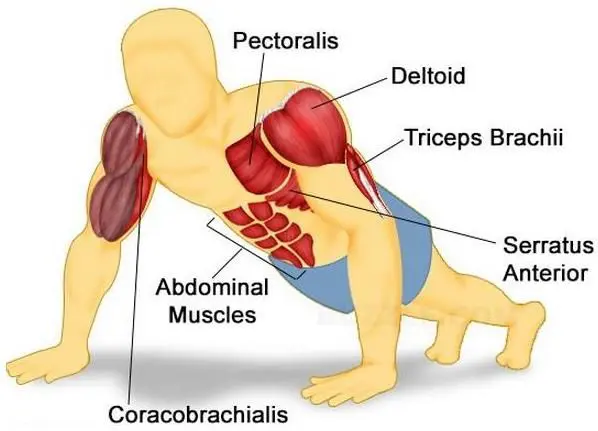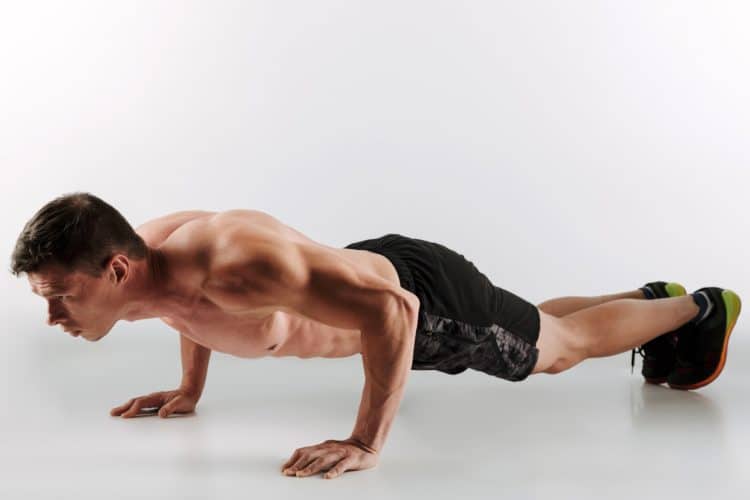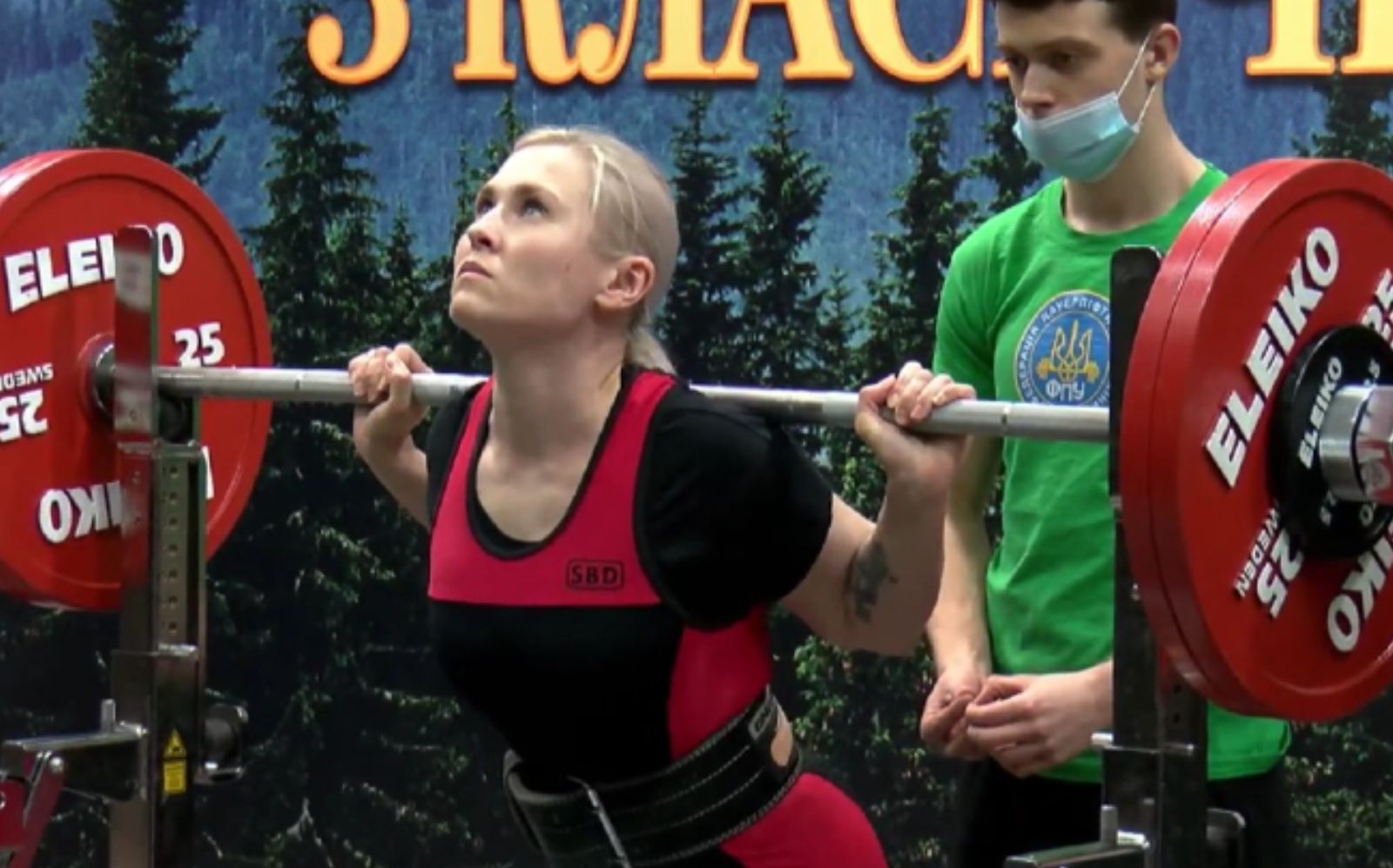Push-ups are probably the most widely performed exercise on the planet.
Everyone from soldiers to elite athletes to high-school kids do push-ups. But, despite their widespread use, a lot of personal trainers favor bench presses for their more experienced clients, often labeling push-ups as a beginner exercise.
Needless to say, I’m not one of those trainers!
As an ex-powerlifter, I’ve done my fair share of bench pressing. The bench press was also a cornerstone of my bodybuilding training. However, in my four decades of strength training, I’ve probably done more push-ups than any other exercise.
Why? Because push-ups are AWESOME!
Push-ups teach you how to stabilize your entire body and get comfortable lifting your body weight. As such, they’re more functional than bench presses, meaning they carry over better to activities outside of the gym.
Level Up Your Fitness: Join our 💪 strong community in Fitness Volt Newsletter. Get daily inspiration, expert-backed workouts, nutrition tips, the latest in strength sports, and the support you need to reach your goals. Subscribe for free!
In addition, you can do push-ups anywhere and anytime. Consequently, they’re the ultimate excuse-free upper body workout. In fact, you could drop down and pump out a set of push-ups right now.
It’s also interesting to note that push-ups and bench presses use the same muscle activation pattern (1). In addition, studies indicate that push-ups can be effective for building muscle mass and strength (2). So much for bench presses being superior to push-ups.
However, to get the most from push-ups, you must a) do them regularly and b) follow a structured routine. A few occasional sets won’t do anything for your push-up performance or upper body strength and size.
With that in mind, here is a tried-and-tested 6-week program for push-up mastery. As well as turning you into a push-up ninja, this routine will add slabs of new muscle to your chest, shoulders, and triceps.
Push-Up Basics
Before we launch into my six-week program push-up mastery, let’s take a moment to ensure we’re all on the same page regarding this classic bodyweight exercise!
Push-Ups: Correct Form
If there is one thing I hate to see, it’s poorly performed push-ups. Improper push-up form not only makes this exercise less effective, but it also increases the risk of chronic and acute injuries. Your shoulders and lower back are especially vulnerable.
So, with that in mind, follow these step-by-step instructions to perfect push-up performance.
- Kneel down and place your palms flat on the floor, hands about shoulder-width apart. Your fingers should be pointing forward.
- Rotate your arms slightly so your elbows are pointing backward. This increases upper back engagement and shoulder stability.
- Walk your feet out and back until your legs and body are straight. Brace your core. Contract your quads and glutes to stabilize your lower body.
- Bend your arms and lower your chest to within an inch of the floor. Keep your upper arms close to your body. Do not drop your head toward the floor; keep your neck neutral.
- Pause with your chest just above the floor for a second, and then extend your arms. Return to the starting position.
- That’s one rep – keep going!
Tips:
- Inhale as you descend and exhale as you return to the starting position.
- Imagine you are pushing the floor away rather than lifting your body.
- Push your hands inward to maximize pec engagement.
- Bend your legs and rest on your knees to make push-ups more manageable.
- Raise your feet to put more weight on your hands, or rest your hands on handles or blocks to increase your range of motion to make push-ups more challenging.
Push-Ups: Muscles Worked
Push-ups are a compound upper body exercise. As such, they involve multiple joints and muscles working together. In fact, push-ups work all of your major pushing muscles. That said, the primary muscles trained by push-ups are:
- Pectoralis major – known as the pecs for short, this muscle is the agonist or prime mover during push-ups. In other words, it’s the muscle doing most of the work. The pecs are essentially your chest muscles.
- Deltoids – the deltoids or delts are your main shoulder muscles. There are three sets of deltoid fibers, called heads: anterior (front), medial (side), and posterior (rear). All three heads are active during push-ups, but the anterior fibers are working the hardest.
- Triceps brachii – located on the back of your upper arm, the triceps are responsible for extending your elbows. Because of their relatively small size, the triceps usually fail before the pecs and delts during push-ups. Stronger triceps usually lead to increased push-up performance.
- Core – this is the collective name for the muscles of your midsection, including the rectus abdominis, obliques, and transverse abdominis. These muscles contract during push-ups to stabilize your lumbar spine. If your hips drop during push-ups, a weak core could be the culprit.
- Lower body – make no mistake; push-ups are any upper body exercise. That said, you’ll find them easier and more effective if you tense your quads and glutes when you do them.

In push-ups, your body is your bench, and it needs to be rigid and stable. If it isn’t, you won’t be able to generate as much force with your chest, shoulders, and arms. So, long story short, tense your lower body to make push-ups safer and more effective.
6-Week Program for Push-Up Mastery Mass and Strength
Do you want to get better at push-ups while building and strengthening your chest, shoulders, and triceps? Then you’ve come to the right place! This tried-and-tested program will help you master push-ups in just six weeks.
But before you drop down and start banging out the reps, make sure you spend a few minutes preparing your muscles and joints for what you are about to do. This will reduce your risk of injury and increase workout performance by improving neuromuscular proficiency.
Start with 5-10 minutes of easy cardio followed by dynamic mobility and flexibility exercises for the muscles and joints you’re about to use. Next, do a couple of sets of band pull-aparts to activate your upper back and stabilize your shoulders. Finally, do 1-2 submaximal sets of push-ups to practice and perfect your technique.
Ready to go? Then let’s get to work!
Program Overview
This program involves three push-up-based workouts per week. Ideally, they should be performed on non-consecutive days, e.g., Monday, Wednesday, and Friday.
Each workout is purposely short so you can put more of your energy into your push-ups. However, there are also a couple of supplementary exercises for the sake of variety and boosting performance and muscle growth.
Level Up Your Fitness: Join our 💪 strong community in Fitness Volt Newsletter. Get daily inspiration, expert-backed workouts, nutrition tips, the latest in strength sports, and the support you need to reach your goals. Subscribe for free!
Workout 1 – Max Effort Push-Ups
| Exercise | Sets | Reps | Rest | |
| 1 | Push-up | 3 | Max | 5 minutes |
| 2 | Diamond push-ups | 3 | 8-15 | 90 seconds |
| 3 | Triceps pushdown | 3 | 8-15 | 90 seconds |
Workout #1 involves doing three all-out sets of push-ups. Simply do as many reps as you can in perfect form. This workout will build your push-up capacity while measuring your progress. The long rests ensure that you can give each set your best effort. While your rep count will undoubtedly decrease from set to set, performance drop-off should be minimal.
Related: How Many Push-Ups Should I Be Able to Do? The Ultimate Guide
Workout 2 – Push-Up Volume
| Exercise | Sets | Reps | Rest | |
| 1 | Push-ups | 10 | 50% of max | 60 seconds |
| 2 | Paused push-ups* | 3 | 8-15 | 90 seconds |
| 3 | Dips | 3 | 8-15 | 90 seconds |
* Pause with your chest an inch above the floor for 2-3 seconds before extending your arms. This exercise increases strength and power off the floor.
Your second workout involves doing multiple sets of 50% of your best set from session #1. So, if you did 22 reps during the first workout, today you’ll be doing sets of 11 reps. This adds up to a lot of volume, and volume is one of the main drivers of muscle growth.
Keep your rests to a strict 60 seconds between sets. However, don’t worry if your rep count decreases toward the end of this workout; just do your best to hit that 50% target. Similarly, don’t be concerned if 50% of your max reps is not a whole number, e.g., you did 19. Just round it down and use that figure instead.
Workout 3 – Push-Up Mechanical Drop Set
| Exercise | Sets | Reps | Rest | |
| 1a | Decline push-ups | 3 | Max | 2 minutes between drop sets |
| 1b | Push-ups | |||
| 1c | Incline push-ups | |||
| 2 | Dumbbell skull crusher | 3 | 8-15 | 90 seconds |
Your final push-up workout of the week will test your physical and mental endurance. It involves doing several different types of push-ups back-to-back in a mechanical drop set.
A mechanical drop set involves doing several similar exercises, each one slightly easier than the last. In this instance, you’ll be reducing the load on your hands from one variation to the next. Move quickly between exercises, and only rest when you have completed the final push-up variation.
Mechanical drop sets, like the regular kind, increase time under tension and push your muscles beyond their typical failure point.
Here’s a video of your mechanical drop set in action.
FAQ’s
Do you have a question about my push-up mastery program? No problem, because I’ve got the answers! Alternatively, please drop me a line in the comments section below, and I’ll get back to you as soon as possible.
1. Is this program suitable for beginners?
This 6-week push-up mastery program is mainly for intermediate/advanced exercisers. Ideally, you should be able to do at least ten perfect push-ups before attempting it. That said, you could do kneeling push-ups to make it more accessible and beginner-friendly. However, that may not be practical for all the workouts.
Therefore, if you struggle to do ten push-ups with perfect form, you will probably make adequate progress from a more straightforward program, e.g., doing 2 to 3 sets of push-ups three times a week.
2. Can I modify this program to two workouts per week?
You certainly can! Older exercisers and anyone with impaired recovery may get better results from less frequent workouts. To do this, set up your training as follows:
| Week | Day 1 (e.g., Monday) | Day 2 (e.g., Thursday) |
| 1 | Push-up workout #1 | Push-up workout #2 |
| 2 | Push-up workout #3 | Push-up workout #1 |
| 3 | Push-up workout #2 | Push-up workout #3 |
| 4 | Push-up workout #1 | Push-up workout #2 |
| 5 | Push-up workout #3 | Push-up workout #1 |
| 6 | Push-up workout #2 | Push-up workout #3 |
3. Are push-ups all I need for a great-looking upper body?
While a regular diet of push-ups will develop your chest, shoulders, and triceps, they don’t do much for your back muscles or biceps. As such, while push-ups are a great exercise, they are not the only thing you need for a great-looking upper body.
I suggest you combine this push-up routine with my 6-week Pull-Up Program. These two plans will ensure you develop your pushing and pulling muscles equally. In addition, don’t neglect your leg training. You should pay as much attention to your lower body as you do your chest, back, arms, etc.
4. How long can I follow this program?
Provided you are still making progress, you can stick with this routine for longer than the specified six weeks. For instance, if your reps in workout #1 continue to increase, the program is still working. Continue for as long as you are seeing gains.
However, if your progress stalls for more than a couple of weeks, you should switch to a different push-up program.
5. Are push-ups really as good as bench presses for building muscle?
Provided you take your sets to the same level of muscular fatigue, studies suggest that push-ups build the pecs, delts, and triceps as effectively as bench presses (3). However, on the downside, this may mean you end up doing a lot of reps to reach that level of fatigue. With bench presses, you just need to add more weight to avoid resorting to high-rep sets.
Personally, I see no reason to view push-ups and bench presses as an either/or decision. Do both and enjoy all the benefits on offer. Alternatively, choose the one that best matches your needs and goals. The truth is that they’re both great exercises.
Closing Thoughts
Push-ups are not just for beginners. In fact, in terms of effectiveness and safety, they’re almost unbeatable. After all, you can do them anywhere and anytime, and there are no heavy weights to come crashing down on you if you hit muscular failure.
Sure, you’ll probably master standard push-ups eventually and want to progress to more demanding exercises. However, there are plenty of challenging push-up variations to try that will ensure your workouts are never boring or repetitive.
Want to conquer the push-up and reap all the benefits this exercise provides? Then, you need to do them regularly. Try my 6-week program for push-up mastery, and experience the power of the push-up for yourself.
References:
- Gottschall JS, Hastings B, Becker Z. Muscle Activity Patterns do not Differ Between Push-Up and Bench Press Exercises. J Appl Biomech. 2018 Dec 1;34(6):442-447. doi: 10.1123/jab.2017-0063. PMID: 29809073.
- Kikuchi N, Nakazato K. Low-load bench presses and push-ups induce similar muscle hypertrophy and strength gain. J Exerc Sci Fit. 2017 Jun;15(1):37-42. doi: 10.1016/j.jesf.2017.06.003. Epub 2017 Jun 29. PMID: 29541130; PMCID: PMC5812864.
- Kotarsky CJ, Christensen BK, Miller JS, Hackney KJ. Effect of Progressive Calisthenic Push-up Training on Muscle Strength and Thickness. J Strength Cond Res. 2018 Mar;32(3):651-659. doi: 10.1519/JSC.0000000000002345. PMID: 29466268.









